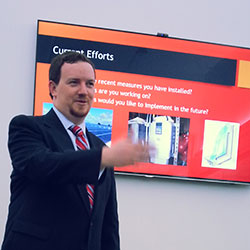EDF Climate Corps fellow | August 27, 2014
By: Daniel Ohrenstein, graduate student at Cornell University

Google Maps does not understand Boston. During my first drive to the Boston Marine Industrial Park, the app took me in a complete loop from Somerville down to Fenway and back. There is no substitute in this town for knowing the streets and walking them yourself. Likewise, to move an energy project along, you have to get out from your desk and start shaking hands to make real progress.
In many ways, Boston has led the country in energy efficiency. Boston was the first municipality to mandate that all private new construction in the city must follow LEED standards. To encourage energy efficiency efforts, Boston established BERDO—the Boston Energy Reporting and Disclosure Ordinance. This legislative act requires buildings above a certain square footage within the city to disclose their energy usage data to the City. Plus, Boston has built over time a uniquely collaborative relationship with the energy utilities—a collaboration which has been central to my efforts this summer.
My fellowship has consisted of two objectives: promoting energy efficiency solutions for the industrial and commercial tenants of the Boston Marine Industrial Park as well as gathering data to study the feasibility of a district energy system for the park. The BMIP is a dynamic area that houses many different kinds of tenants: seafood processors, storerooms, an industrial bakery, the shipyard, office space, as well as the brewery. Many of the buildings within the BMIP have been repurposed from the time the park was a Navy and Army base. There are many great opportunities in the older buildings for energy efficiency improvements as well as many industrial tenants who could utilize district energy. In brief, district energy means that the power utility also supplies hot water, steam, or chilled water throughout a neighborhood to supply the inputs to run building heating and cooling. District energy can save building operators on mechanical equipment replacement, operations and maintenance costs, as well as energy. Most importantly, district energy cuts carbon emissions.
So, along with my colleagues at the Boston Redevelopment Authority, which is the landlord for the BMIP, we have been meeting with the facilities and financial managers for the tenants around the park and discussing their aspirations for energy efficiency improvements as well as the possibility of a district energy system in the near future. Many of the facilities managers for BMIP businesses have been waiting for years for a serious district energy proposal to come along. I am glad to be playing a role this summer in moving this proposal along. The central portion of the effort has been data gathering, and the tenants have been gracious and helpful in sharing their energy use data. Of course, in the long run we at the BRA are trying to make the BMIP a more competitive and convenient location for businesses to locate their operations.
The key points I’ve learned this summer are, first, present hard numbers for the savings businesses can expect if they implement your proposal. Second, listen carefully to the ideas of stakeholders—you never know what hidden opportunities are there to be explored. Third, everyone in this town, from business owners to government officials, are eager to save energy. Overall, the experience has been very fruitful, and I’m glad to have helped direct the course of future energy development in this dynamic district.
This blog was originally posted by the Boston Redevelopment Authority.
About EDF Climate Corps
EDF Climate Corps (edfclimatecorps.org) taps the talents of tomorrow’s leaders to save energy, money and the environment by placing specially trained EDF fellows in companies, cities and universities as dedicated energy problem solvers. Working with hundreds of leading organizations, EDF Climate Corps has uncovered nearly $1.3 billion in energy savings. For more information, visit edfclimatecorps.org. Read our blog at edfclimatecorps.org/blog. Follow us on Twitter at twitter.com/edfbiz and on Facebook at facebook.com/EDFClimateCorps.